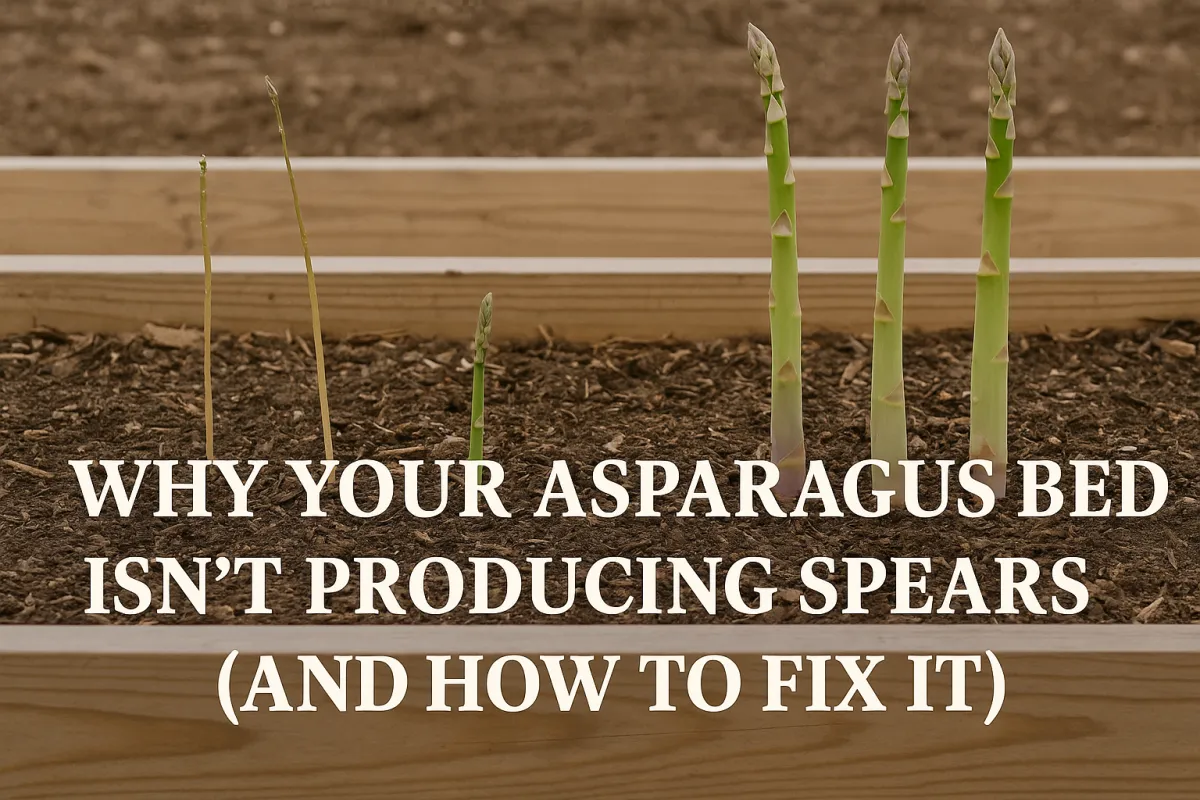
Why Your Asparagus Bed Isn’t Producing Spears (and How to Fix It)
The Empty Bed Lesson
I’ll never forget the first spring I planted asparagus. I walked out expecting a flush of green spears breaking through the soil, but all I found was bare dirt and a couple of wispy shoots. It’s a humbling moment when you realize asparagus isn’t like lettuce or beans—you don’t plant it in May and eat it in June. Asparagus makes you earn it.
And that’s where most folks trip up. If your bed isn’t producing, it’s usually not because asparagus is “hard to grow.” It’s because something in the foundation is off—whether that’s timing, care, soil, or competition. Let’s walk through the five main reasons your asparagus bed is falling short, and more importantly, how you can fix it.
Understanding Asparagus Growth
Asparagus is a perennial crop with a root system (called crowns) that digs deep and builds strength over time. Unlike annuals, it doesn’t reward impatience. A healthy bed can feed you for 15–20 years, but only if the first few years are managed correctly.
USDA Zones 3–8 are prime asparagus country.
Cooler northern zones get a short but intense spring flush.
Warmer southern zones stretch the season, but heat shuts the spears down earlier.
Knowing your zone helps set realistic expectations.
Reason 1: Your Bed Is Too Young
This is the most common mistake. Folks plant crowns one spring and expect a full harvest the next. Asparagus takes time to establish.
The timeline looks like this:
Year 1: Let every spear grow into ferns. This builds energy in the crowns.
Year 2: Harvest lightly for two weeks, then let the rest fern out.
Year 3+: You can finally harvest for 6–8 weeks.
Push it too soon and you’ll stunt the plant for years to come.
Grandma’s Tip: “Don’t eat it all before it’s grown strong. A crown’s like a calf—you let it grow before you butcher.”
Reason 2: Overharvesting Has Weakened Crowns
Even once your bed is mature, you can take too much. Overharvested crowns don’t store enough energy, so the next spring’s spears come up thin, weak, and short-lived.
Fix it this season:
Harvest for 6–8 weeks maximum once established.
Stop harvesting when spears thin down to pencil-size.
Always leave ferns to grow through summer—those are the plant’s food factory.
Pro Tip: The spear tells you when to stop. When they look like pencils, the harvest window is closed.
Reason 3: Poor Soil Prep or Nutrient Deficiency
Asparagus is a heavy feeder. If the soil wasn’t built right from the start, or if it hasn’t been fed regularly, your plants will show it.
Signs: weak spear growth, yellowing ferns, or beds that never seem vigorous.
Step-by-step soil fix:
Top-dress with compost every spring before spears emerge.
Add bone meal or rock phosphate for root strength.
Use mulch (straw, leaves, or wood chips) to conserve nutrients and moisture.
In sandy soils, increase organic matter. In clay, improve drainage with raised beds or coarse compost.
Healthy soil equals strong crowns.
Reason 4: Weed Competition
Weeds are a silent yield killer. Asparagus doesn’t compete well because its roots grow slowly and deep. Weeds steal nutrients, water, and sunlight.
Fix it:
Mulch the bed thick with straw or leaves each year.
Hand-weed carefully—don’t hoe deep or you’ll damage crowns near the surface.
Grandma’s Tip: “Keep your asparagus bed as clean as your kitchen floor if you want it to feed you.”
Reason 5: Pest and Disease Pressure
If age, harvest, soil, and weeds check out, pests or disease may be holding your bed back.
Common culprits:
Asparagus beetles: chew ferns and weaken crowns.
Fusarium wilt: causes yellow, weak ferns.
Rust: orange spots on stems and foliage.
Fix it organically:
Handpick beetles and drop them in soapy water.
Use neem oil during active beetle outbreaks.
Always cut down ferns after frost and remove them—don’t compost if diseased.
Rotate asparagus beds only if disease becomes severe.
Pro Tip: Always burn or haul away fern debris. Disease overwinters in what you leave behind.
Faith & Patience in Perennials
Asparagus is the kind of crop that forces patience. You can’t rush it, but once it’s established, it blesses you for decades.
Ecclesiastes 3:1 says, “To everything there is a season, a time for every purpose under heaven.” That’s asparagus in a nutshell. You plant, you wait, and you trust the unseen work beneath the soil. It’s a good reminder that some of the best rewards in life come only after steady tending.
Closing: Your Next Step
If your asparagus bed isn’t producing spears, the cause almost always comes down to one of these five:
Too young
Overharvested
Poor soil or nutrients
Weeds stealing resources
Pest or disease pressure
The fix is simple once you identify the root cause. Evaluate your bed honestly this season and take the next corrective step.
👉 To make it easier, I’ve put together a printable Asparagus Bed Care Calendar you can keep in your garden shed. Download it, tack it up, and let it guide your harvests for years to come.
With a little patience and the right adjustments, you’ll move from empty rows to a basket of spears that keep coming every spring.


Facebook
Instagram
X
Youtube